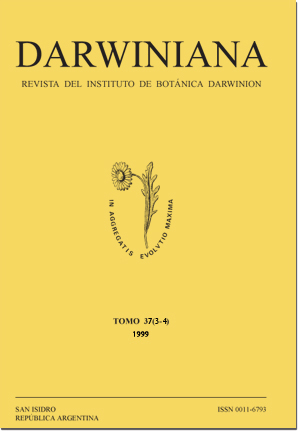Cytoembryology and reproductive behavior of diploid Paspalum hydrophilum and its hybrids with P. palustre (Poaceae, Paniceae)
DOI:
https://doi.org/10.14522/darwiniana.2014.373-4.360Keywords:
Paspalum hydrophilum, Paspalum palustre, Interspecific hybrids, Genomic relationships, Breeding systemAbstract
Paspalum hydrophilum Henrard is a tetraploid, facultative apomictic, pseudogamous and selfcompatible species for which occasional diploid and triploid plants have also been found. Three new plant collections from Mato Grosso, Brasil, were cytologically and embryologically surveyed. All three accessions were diploid (2n = 2 x = 20), sexual, and allogamous due to self-incompatibility. Reciprocal crosses concerning two diploid P. hydrophilum accessions and one plant of diploid P. palustre Mez produced several interspecific hybrids. Crossability, the number of hybrids obtained for every 100 pollinated spikelets, ranged from approximately 8% to 28%. The hybrids showed regular meiotic behaviour with 10 bivalent chromosome associations at meiosis, indicating a high chromosome homology among these species. The F1 hybrids inherited self-incompatibility from both parents, attributable to pollen-pistil interactions that arrested pollen tube growth at the central axis of the stigma. Low seed fertility was observed under open pollination. Seed performance ranged up to approximately 23% when parental pollen was dusted on hybrids. This performance may allow to transfer genes among these species. Our results showed a close phylogenetic relationship between P. hydrophilum and P. palustre and indicate the feasibility of interspecific genetic exchange. Though the distribution area of P. palustre overlaps the more extensive area of P. hydrophilum, natural hybridization was not observed. Allopatry of the diploid cytotypes of these species may account for lack of natural hydrization.Downloads
Published
31-12-2011
How to Cite
Martínez, E. J., & Quarín, C. L. (2011). Cytoembryology and reproductive behavior of diploid Paspalum hydrophilum and its hybrids with P. palustre (Poaceae, Paniceae). Darwiniana, Nueva Serie, 37(3-4), 243–251. https://doi.org/10.14522/darwiniana.2014.373-4.360
Issue
Section
Reproductive Biology
License

Starting on 2012, Darwiniana Nueva Serie uses Licencia Creative Commons Atribución-NoComercial 2.5 Argentina .






